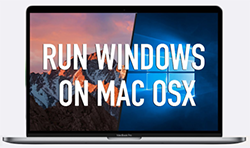Difference between revisions of "How to Install Windows on a Mac"
| Line 35: | Line 35: | ||
* Not enough memory | * Not enough memory | ||
| − | If you get this error when trying to resume windows then you will need to go to the "Virtual Machine" tab in the menu bar and click shut down. Once your virtual windows is shut down click on "Settings..." under "Virtual Machine." This will bring up a window with system settings for the virtual machine, click on "Processors and Memory." Next, move the slider, or type in | + | If you get this error when trying to resume windows then you will need to go to the "Virtual Machine" tab in the menu bar and click shut down. Once your virtual windows is shut down click on "Settings..." under "Virtual Machine." This will bring up a window with system settings for the virtual machine, click on "Processors and Memory." Next, move the slider, or type in 8192. You will need to have at least 16 GB of RAM in order for your Mac to function properly. |
* Not enough hard drive space | * Not enough hard drive space | ||
Revision as of 13:10, 5 May 2021
Contents
WARNING for Apple M1 users
As of January, 2021, there is not a way to run Windows on an Apple M1 Macbook at this time.
Apple discontinued Bootcamp and neither Parallels nor VMware have released an update that supports the new M1 chip.
Mac memory and drive space requirements
The College of Engineering requires the following minimum specifications for Macs:
- You need 16 GB of RAM (memory). A Windows VM needs 8 GB and your Mac will need another 8 GB in addition.
- You need at least 250 GB of storage with at least 75 GB of free drive space (more may be needed depending on the number and size of Windows applications).
Note: Windows will not run on a flash/USB drive. If you don't have enough free drive space, you will need to either free up space or find a different computer.
Video: How to check your Mac's memory and storage
Where to get the software
- Windows 10 - visit UA's webstore via this link: https://oit.ua.edu/software/windows-10-education/ and click on the Microsoft tab.
- VMware Fusion - visit the same webstore: https://oit.ua.edu/software/windows-10-education/ and click on the VMware tab and select the latest version of Fusion.
- Bootcamp - built into MacOS. Look in Applications, Utilities for the Bootcamp Assistant.
Video: How to download and Install VMware Fusion
Video: How to install Windows with Bootcamp
Common VMware Errors
- Broken Pipe Error
This occurs when you have not given permissions to VMware fusion on your Mac. Open system preferences on your mac, then click security and privacy. On the general tab, in the bottom half, you should see something similar to “System software from vendor “VMware, Inc.” was blocked from loading.” with option to click on “Allow”. You may need to click the lock at the bottom of the page to make changes. Once you click allow relaunch VMware fusion.
- Not enough memory
If you get this error when trying to resume windows then you will need to go to the "Virtual Machine" tab in the menu bar and click shut down. Once your virtual windows is shut down click on "Settings..." under "Virtual Machine." This will bring up a window with system settings for the virtual machine, click on "Processors and Memory." Next, move the slider, or type in 8192. You will need to have at least 16 GB of RAM in order for your Mac to function properly.
- Not enough hard drive space
If you didn't give your VM enough drive space and need to take more from your Mac side and move it to the windows side then first click the "Virtual Machine tab" and select shut down to close the windows VM. Next click the "Window" tab and select "Virtual Machine Library." Next, right click the VM that you want to give more drive space and click "settings..." Next select "Hard Disk" under removable devices and then move the slider or type in the amount of drive space that you would like to have.
Note: The number you enter will be the total drive space that you have in windows not how much you are adding

